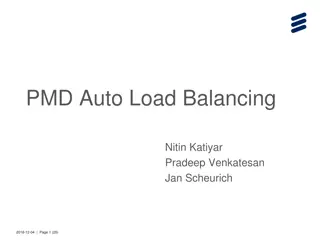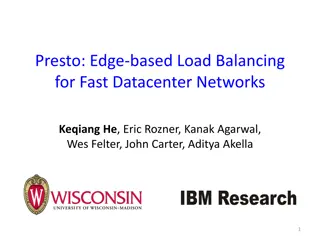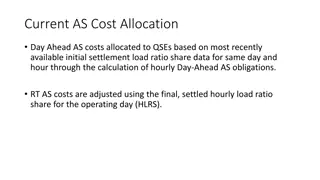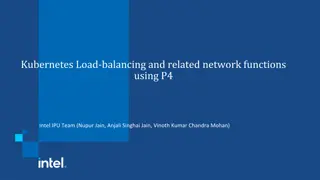
Hierarchical Load Balancing for Efficient Resource Management
Concept of Hierarchical Load Balancing, a method to prevent response time degradation in systems with varying node loads. This approach involves forming groups of nodes in a tree-like hierarchy, with each group having a leader for communication. Learn about building the hierarchy, assigning tasks efficiently, and managing load imbalances effectively.
Download Presentation

Please find below an Image/Link to download the presentation.
The content on the website is provided AS IS for your information and personal use only. It may not be sold, licensed, or shared on other websites without obtaining consent from the author. If you encounter any issues during the download, it is possible that the publisher has removed the file from their server.
You are allowed to download the files provided on this website for personal or commercial use, subject to the condition that they are used lawfully. All files are the property of their respective owners.
The content on the website is provided AS IS for your information and personal use only. It may not be sold, licensed, or shared on other websites without obtaining consent from the author.
E N D
Presentation Transcript
HIERARCHICAL LOAD BALANCING ISMAEL ALONSO
THE PROBLEM Suppose you have a set of agents (or nodes) capable of processing Jobs Any one of these agents are assigned jobs externally Clients connect to them and send them work directly If a subset of these agents has a bigger load than the rest the response time may degrade There is a caveat here, we ll get to this later How to notice there is a problem and what to do in response?
THE PROBLEM We have several options Fully centralized load balancing Doesn t scale well Fully distributed load balancing Takes some time to reach good decisions Can we compromise?
HIERARCHICAL LOAD BALANCING Yes, we can! We are going to form groups of nodes, each one having a leader Any one node may only communicate with a leader or with their children Unless more on this later. Child nodes can be the leaders of their own subgroup Effectively, the hierarchy will end up looking like a tree.
BUILDING THE HIERARCHY We now have choices Branching factor (2 in my case) Full tree vs complete tree vs a train wreck of a tree Spatial locality or tunneling may influence tree building Truth is, I arranged them as they came Complete tree though, there is some order to my universe How? Remember that all nodes need to be leaves independently of whether they are leaders
TIME TO PUT THE NODES TO WORK Originally three problems: Fibo: linear Sieve of Eratosthenes: n log(log(n)) Square sum (n2) This turned out to be a problem to test the system We ll see why in a minute
WHAT THEN? Now we need to know the load of the nodes in the hierarchy What do you report though? Remember this mess? 1 cannot report its own to 0 0 cannot have a combined report at L0 Merge up whatever you have Its good enough, trust me
YOU GOT MAIL! An imbalance has been found! A node is 10% above or below average load Freeze! Or don t, but you run the risk of balancing jobs that were completed at balance time Collect all the jobs, aggregate them and pass them up JK, just job metadata: estimated length and owner Each leader defers decisions until its own leader has made decisions Leaders can choose to further aggregate jobs by combining them (this is an optimization)
MORE ON COLLECTION I bet you still remember these shenanigans Aggregating the jobs is not easy, requires synchronization Like a lot of it Cannot pass anything up until you have a complete picture
PROBLEM #1 Unless a node is over capacity, any utilization metric is worthless Suppose you got a node at 20% capacity and another one at 70% capacity Congrats, it s load balancing time! Wait, there are no jobs in the queues wat? To be more specific, hierarchical load balancing in this system is only good if two conditions are met simultaneously: One node is grossly overutilized One node is at least somewhat underutilized
PROBLEM #2 Okay, so, to test this thing we ll skew the job allocation distribution. Sure, let s set up a thread that sends jobs to certain nodes with a frequency and an input size. K cool: n=10002and T=50ms: load is 1.4x10-4% (hmmm right ) n=25002and T=40ms: load is 0.01% (whalp, k) n=60002and T=40ms: int overflow for estimated job size (!!). Also load ~0.2 (better, but not good enough) Ended up putting nodes to sleep while counting it as working for jobs They got off easy, I know
WE HAVE JOB INFO AT THE TOP NOW RefineLB? What s that? As it turns out this is a Charm specific thing and I wanted to build my own Each processor has a set of jobs it owns, ordered by size The processors are also ordered in decreasing order of load (work allocated) Jobs over the average load are donors Jobs under the average load are recipients
IZZYS LAW OF LOADS A node that s already overloaded will tend to stay loaded Don t know if this is a thing, just a suspicion Donors will donate until they re under the average Recipients will receive until they re above the average Repeat until there s not longer both donors and recipients Selected job is one that s just under the potential room of load a recipient can take to go above Or the one immediately above if none below
PROPAGATING THE CHANGES DOWN THE PIPE A leader will communicate with all its children about the decisions made The first level is easy, nothing external to the process really needs to be considered I m sure at this point we re drinking buddies with this bad boy Whalp, there s a few edge cases
SO AGREEMENT? Once everyone is on the same page about what jobs we need to steal from other nodes We just ask for them nicely. Once we get what we want we resume operations and wait some time to start checking whether there is an imbalance again.
MY SYSTEM A little overengineered, perhaps Controllers spawn nodes in a single machine Nodes do the work Controllers spawn them as processes, so getting info out of them isn t trivial We got a dedicated logging node, started directly from a terminal we have access to Fixed location There is a client, just runs the show
MY SYSTEM At some point late last week realized I didn t have time to prep it to run in multiple machines Single local controller spawns as many nodes as we need Remember they don t do real work anymore, so we can spawn virtually an unlimited amount of them Demo?
ANALYSIS Load information is readily available and cheap to send/aggregate To get job info, as many RTTs as levels the tree has are required Propagating the load balancing decisions takes a variable amount of time The big fish executes the process for as many levels as the tree has, but at the end of the process its info is final Nodes closer to leaves must wait until the chain of command has decided what to do (up to log n RTTs) Fetching your jobs takes one RTT






















